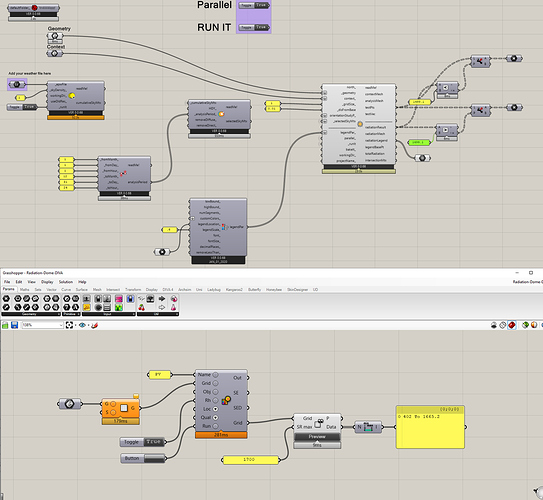Hi,
I’m trying to demonstrate on a basic level the optimized orientation for a PV array by showing where the maximum radiation is coming from the sun on an annual basis. In order to do this I mapped a grid on a semi-spherical dome and ran an analysis both in DIVA and ladybug using the same .epw file (for Beijing).
I am curious why the analyses are yielding different results, both in terms of their absolute kwh/m2 values and the altitude and azimuth. Not totally understanding the back-end of DIVA, I’m wondering if this has anything to do with the Ladybug Cumulative Sky Matrix or some other input in Ladybug.
The maximum kwh/m2 in the Ladybug run is 1,492 kwh/m2 and the DIVA analysis shows ~1,650 kwh/m2. Additionally, it appears these maximum values vary in their altitude and azimuth.
Please image below for reference (as a new user I cannot yet upload attachments and can only upload one image).
Thank you!
Both DIVA and Honeybee are using Radiance for ray-tracing. I’m not sure what they use for calculating cumulative sky but since gendaymtx -A is only available in the source code of Radiance and not the public packages I believe they both use gencumulativesky.
You should make sure that you are using the same radiance parameters in both runs.
Also are you using the same north (+Y) in both studies? The honeybee output looks rotated from the expected north/south.
Thanks Mostapha,
I did my best to use the same parameters - but will do a little more testing to see if I can’t get the results a little closer.
To you question about north. Yes, they are the same (running off the same Rhino file) - the lines you are seeing are just some model lines traced from the center point of the dome to the maximum kwh point value.
Here is an image of the to different scripts below. Thanks again for the reply.
You are using Ladybug in this case. You should try Honeybee’s radiation recipe.
There are several discussions on the forum about why the values between honeybee (Radiance) and Ladybug are slightly different and you can also find a number of validation studies on the forum.
Will do. Thanks again, Mostapha.
Best,
Kenner

